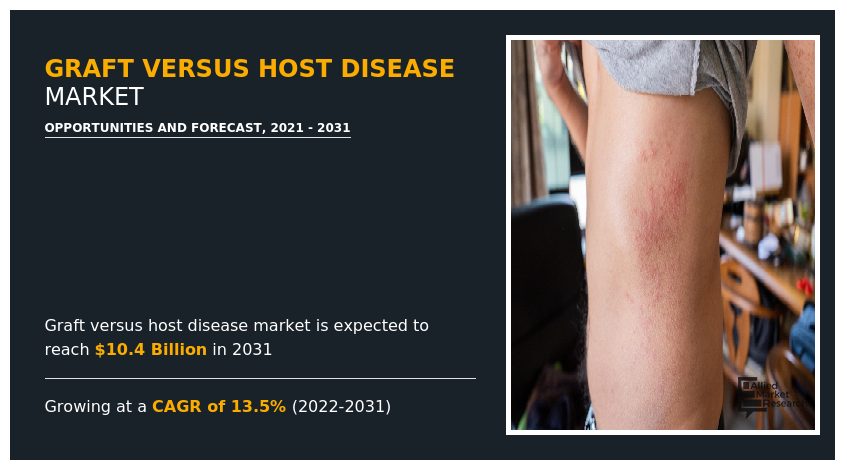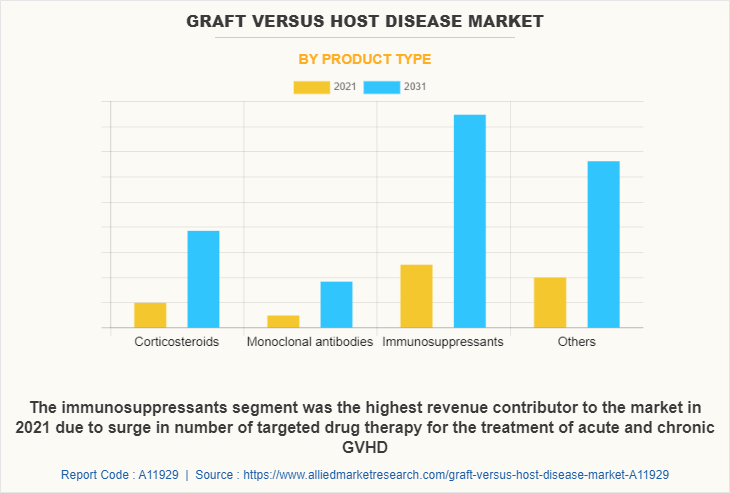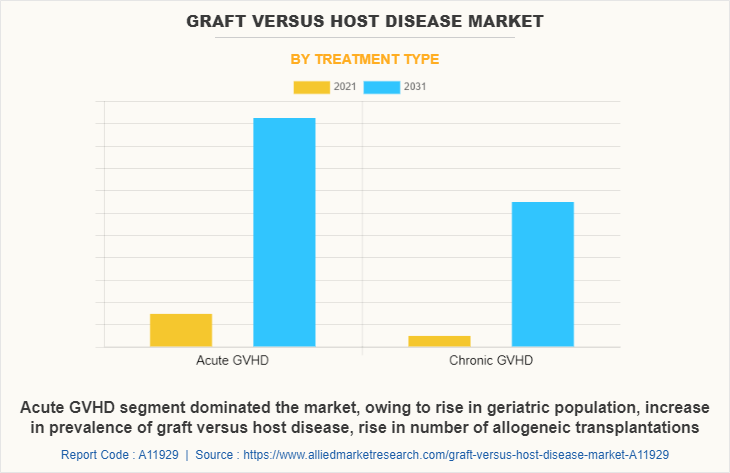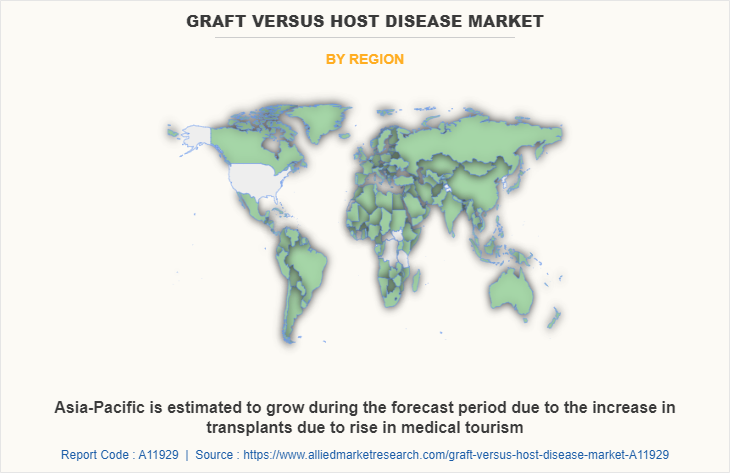Graft Versus Host Disease Market Research, 2031
The global graft versus host disease market was valued at $3.0 billion in 2021, and is projected to reach $10.4 billion by 2031, growing at a CAGR of 13.5% from 2022 to 2031.Graft-versus-host disease (GvHD) is a systemic disorder that occurs when the graft's immune cells recognize the host as foreign and attack the recipient’s body cells. “Graft” refers to transplanted, or donated tissue, and “host” refers to the tissues of the recipient. It is a common complication after allogeneic hematopoietic stem cell transplant (HCT).

The graft versus host disease market is segmented into Product Type, Treatment Type and End Use.
GVHD has been classically classified on the basis of timing of presentation into acute and chronic using a cutoff of 100 days post-transplant. Acute classic GVHD, occurs within 100 days of transplantation with classical clinical features of acute GVHD. Whereas chronic GVHD, occurs after 100 days of transplant with classic clinical features of chronic GVHD. Overlap syndrome may occur at any time post-transplant with features of both acute and chronic GvHD.
Graft-versus-host disease (GVHD) is a significant cause of morbidity and mortality following allogenic hematopoietic stem-cell transplantation, and thus the focus of much ongoing research. A systematic therapy approach is still lacking despite significant progress in the understanding of the pathophysiology, diagnosis, and predisposing factors for both acute and chronic forms of the condition. There is good evidence for initial treatment of both acute and chronic forms of the disease with corticosteroid therapy. However, the most effective approach to steroid-refractory disease remains controversial.
The market is expected to witness a moderate growth during the forecast period, owing to rise in geriatric population and an increase in the prevalence of nephrological, leukemia, myeloma, and lymphoma cancer. Moreover, surge in number of bone marrow transplants been carried around the globe to treat specific types of cancers lead to the growth of the market. Furthermore, rise in the GVHD-prevalent population, advancements in the diagnostic measures of the disease, approval of novel treatments, and a greater range of prophylaxis options are anticipated to lead to significant graft versus host disease market Growthof the market in the near future.
The majority of the player are focused on the development of new products. The launch of new products provides opportunities for the growth of market. For instance, in May 2019, Incyte Corporation, a U.S.-based biopharmaceutical company, received the U.S. Food and Drug Administration (FDA) approval for ‘Jakafi’, a drug indicated for the treatment of steroid-refractory acute GVHD for adults and pediatric patients aged 12 years and above.
However, factors such as high cost of the treatment and lack of awareness about the chemotherapeutic treatment of graft versus host disease are expected to hamper growth of the market up to some extent during the forecast period.
In addition, the coronavirus pandemic has significantly impacted solid organ transplantation (SOT). Early in the outbreak period, transplant societies recommended suspending living kidney transplant programs in communities with widespread transmission to avoid exposing recipients to increased risk of immunosuppression, while recommendations were made to reserve deceased-donor kidney transplantation likely for life-saving indications. SOT recipients may be at high risk from COVID-19 disease due to chronic immunosuppressive treatment and other medical comorbidities. Mortality rates reported between 13 to over 30% in SOT recipients. In addition to high rates of complications and mortality attributable to COVID-19 infections, the pandemic has also led to additional complexities in transplantation.
GVHD market segmentation
The GVHD market is segmented on the basis of products, types, end use, and region. On the basis of product, the market is segmented into corticosteroids, monoclonal antibodies, immunosuppressants, and others. On the basis of type, it is bifurcated into acute and chronic. By end use, the segment is divided into hospital pharmacies, retail pharmacies, and online pharmacies. Region wise, it is analyzed across North America, Europe, Asia-Pacific, and LAMEA.
Product Segment review

By product, the graft versus host disease market size is segmented into corticosteroids, monoclonal antibodies, immunosuppressants, and others. The immunosuppressants segment was the highest revenue contributor to the market in 2021. Owing to surge in number of targeted drug therapy for the treatment of acute and chronic GVHD with the use of immunosuppressants and the rise in number of populations suffering from various disease such as cardiovascular disease, cancer and nephrological disorder contributes to the growth of graft versus host disease market size.
The corticosteroids is expected to be the fastest growing segment during the forecast period. Owing to the fact that steroids are naturally made in the bodies in small amounts. They help to control many functions including the immune system, reducing inflammation, and blood pressure.
Type Segment Review

By type, the graft versus host disease market share is segmented into acute and chronic GVHD. The acute GVHD segment was the highest revenue contributor to the market, owing to rise in geriatric population, increase in prevalence of graft versus host disease, rise in number of allogeneic transplantations.
The chronic GVHD is expected to be the fastest growing segment during the graft versus host disease market forecast period. Owing to rise in geriatric population, there is increase in prevalence of chronic graft versus host disease, which arises due to surge in number of allogeneic transplantations and increase in approval of new drugs for the treatment of chronic GVHD, so that people with chronic graft-versus-host disease (GVHD), with a common complication of bone marrow and stem cell transplants, get new treatment options.
End Use Segment Review
By End Use
The online pharmacies segment is anticipated to be the fastest growing segment during the forecast period
By end use, the hospital pharmacies segment was the highest revenue contributor to the market owing to increase in demand for transplantation drugs due to surge in the number of allogeneic transplantations. For instance, most transplant patients take between 5 and 15 medications daily, with doses due one to four times daily, which contribute in the growth in demand for graft versus host disease market significantly.
The online pharmacies segment is anticipated to be the fastest growing segment during the forecast period. The pandemic has changed the way people live and there has been a shift in preferences; more number of people are now turning to online pharmacies that have a wide range of wellness products in addition to general pharmaceutical products, contributing in the growth of graft versus host disease market analysis.
Region Segment Review

Region wise, the graft versus host disease market is analyzed across North America, Europe, Asia-Pacific, and LAMEA. The North America market was dominant, in terms of revenue among other regions in 2021, owing to increase in the number of organ donation of deceased persons for transplantation, increase in the allogenic transplantation procedure, and surge in the number of cancer patients in this region.
Asia-Pacific is estimated to grow during the forecast period. Rise in geriatric population and therefore the need for transplants will eventually lead to increase in the demand for drugs such as corticosteroids and monoclonal antibodies for the treatment of the graft versus host disease. Further, with that the increase in development of such medicines to fulfil the unmet medical needs and burgeoning demand for personalized medicine are the factors that propel the growth of the GVHD market size.
Key players that operate in the global graft versus host disease industry include AbbVie, Accord Healthcare Limited, Asahi Kasei, Bristol Myer Squibb, GlaxoSmithKline PLC, Incyte Corporation, Merck & Co, Novartis, Pfizer and Sanofi.
KEY BENEFITS FOR STAKEHOLDERS
- The study provides an in-depth analysis of the graft versus host disease market, and the current graft versus host disease market trends and future estimations to elucidate imminent investment pockets.
- It presents a quantitative analysis of the market from 2022 to 2031 to enable stakeholders to capitalize on the prevailing market graft versus host disease market opportunity.
- Extensive analysis of the market based on procedures and services assists to understand the trends in the graft versus host disease industry.
- Key players and their strategies are thoroughly analyzed to understand the competitive outlook of the market.
Graft Versus Host Disease Market Report Highlights
| Aspects | Details |
| By Product Type |
|
| By Treatment Type |
|
| By End Use |
|
| By Region |
|
| Key Market Players | Abbvie Inc, Asahi Kasei Corporation, Merck & Co., Incyte Corporation, Accord Healthcare Limited, Bristol Myer Squibb, Pfizer Inc., Sanofi, Novartis AG, Glaxosmithkline plc |
Analyst Review
This section provides various opinions of top-level CXOs in the graft versus host disease market. In accordance to several interviews conducted, the graft versus host disease market is expected to witness a significant growth in the future, owing to increase in prevalence of cancer patients.
According to the perspectives of CXOs, global graft versus host disease market is expected to witness a steady growth in the future. Increasing prevalence of graft versus host disease due to increase in number of allogenic transplantation and increased disease diagnosis rate are some of the factors which drives the growth of the market. However, high cost of the treatment and high investment in the clinical trials, and lack of awareness about GVHD are expected to hamper the growth of the market up to some extent over the forecast period.
On the contrary, rise in advancements in treatment method and increase in product approval for the treatment of graft versus host disease are expected to provide opportunities for the growth of the global graft versus host disease market in future. For instance, in July 2021, Equillium, Inc. announced the completion of an end-of-phase 1 meeting with the U.S. Food and Drug Administration (FDA) for use of itolizumab in first-line treatment of patients with acute graft-versus-host disease (aGVHD).
Further, North America is expected to witness highest growth, in terms of revenue, owing increase in the number of transplantations and increase in the number of advancements for the treatment of GVHD propels the market of graft versus host disease.
Asia-Pacific was the second largest contributor to the market in 2021, and is expected to register the fastest CAGR during the forecast period, owing to increase in prevalence of cancer patients which leads to increase in the GVHD-prevalent population.
Few upcomming trends of GVHD market includes the increased usage of immunosuppressants and development of personalized medicine.
The North America regional market dominated in 2021 of owing to increase in the number of organ donation of deceased persons for transplantation coupled with increase in the allogenic transplantation procedure.
The global Graft Versus Host Disease Market was valued at $2,968.6 million in 2021 and is expected to register a CAGR of 13.5% during the forecast period.
Bristol, GlaxoSmithKline PLC, Incyte, Merck and Novartis AG are the few top players operating in Graft Versus Host Disease Market.
Factors such as high cost of the treatment and lack of awareness about the chemotherapeutic treatment of graft versus host disease might restrain the market growth.
Corticosteroids are mostly used in treating patients suffering from graft versus host disease. This is due its advantages such as it helps in reducing inflammation and suppressing the immune system.
Key strategies implemented by major players include product launches, agreements and collaborations.
Asia Pacific is expected to be the fastest growing region globally. This is mainly due to the rise in the healthcare infrastructure coupled with the steady increase in Hematopoietic stem cell transplantation (HSCT) in countries such as India, China and Japan among others.
Loading Table Of Content...


